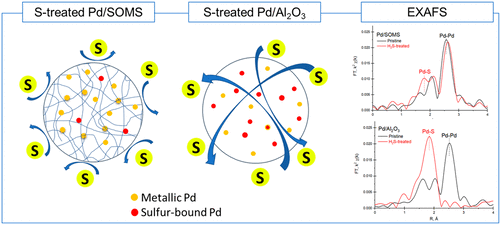当前位置:
X-MOL 学术
›
Ind. Eng. Chem. Res.
›
论文详情
Our official English website, www.x-mol.net, welcomes your
feedback! (Note: you will need to create a separate account there.)
Aqueous-Phase Hydrodechlorination of Trichloroethylene over Pd-Based Swellable Organically Modified Silica: Catalyst Deactivation Due to Sulfur Species
Industrial & Engineering Chemistry Research ( IF 3.8 ) Pub Date : 2019-03-01 , DOI: 10.1021/acs.iecr.8b05979 Gokhan Celik 1 , Saurabh A. Ailawar 1 , Seval Gunduz 1 , Jeffrey T. Miller 2 , Paul L. Edmiston 3 , Umit S. Ozkan 1
Industrial & Engineering Chemistry Research ( IF 3.8 ) Pub Date : 2019-03-01 , DOI: 10.1021/acs.iecr.8b05979 Gokhan Celik 1 , Saurabh A. Ailawar 1 , Seval Gunduz 1 , Jeffrey T. Miller 2 , Paul L. Edmiston 3 , Umit S. Ozkan 1
Affiliation

|
One of the problems of catalytic water treatment systems is that sulfur-containing species present in contaminated water have a detrimental effect on the catalytic performance because of strong interactions of sulfur species with active metal sites. In order to address these problems, our research has focused on developing a poison-resistant catalytic system by using a novel material, namely, swellable organically modified silica (SOMS), as a catalyst scaffold. Our previous investigations demonstrated that the developed system was resistant to chloride poisoning, active metal leaching, and carbon deposition under reaction conditions. This study examines the sulfur tolerance of the developed catalytic system for hydrodechlorination (HDC) of trichloroethylene (TCE) by subjecting Pd-incorporated samples to different sulfur species, including sulfates (SO42–), bisulfides (HS–), and hydrogen sulfide (H2S). The pristine and sulfur-treated catalysts were then tested for aqueous- and gas-phase HDC of TCE and characterized by several techniques, including N2 physisorption, X-ray photoelectron spectroscopy (XPS), extended X-ray absorption fine structure spectroscopy (EXAFS), and temperature-programmed reaction (TPrxn) with H2. The investigations were also performed on Pd/Al2O3, a commercially used HDC catalyst, to have a basis for comparison. The activity and characterization results revealed that Pd/Al2O3 underwent deactivation due to exposure to sulfur-containing compounds. Pd/SOMS, however, exhibited better resistance to aqueous sulfates, bisulfides, and gas-phase H2S. In addition, the removal of sulfur species from completely poisoned catalysts was found to be more facile in Pd/SOMS than Pd/Al2O3. The tolerance of Pd/SOMS to sulfur poisoning was attributed to stem from the novel characteristics of SOMS, such as swelling ability and extreme hydrophobicity.
中文翻译:

基于Pd的可溶胀有机改性二氧化硅上的三氯乙烯的水相加氢脱氯:由于硫物种而导致的催化剂失活
催化水处理系统的问题之一是,由于硫物质与活性金属位点之间的强烈相互作用,存在于污水中的含硫物质对催化性能具有不利影响。为了解决这些问题,我们的研究集中在通过使用一种新型材料,即可溶胀的有机改性二氧化硅(SOMS)作为催化剂支架,来开发一种抗毒催化体系。我们以前的研究表明,开发的系统在反应条件下具有抗氯化物中毒,活性金属浸出和碳沉积的能力。这项研究通过使掺钯的样品经历不同的硫种类,研究了已开发的三氯乙烯加氢脱氯催化体系(HDC)的耐硫性,4 2–),二硫化物(HS –)和硫化氢(H 2 S)。然后测试原始和硫处理的催化剂的TCE的水相和气相HDC并通过多种技术进行表征,包括N 2物理吸附,X射线光电子能谱(XPS),扩展X射线吸收精细结构能谱(EXAFS) ),以及与H 2的程序升温反应(TP rxn)。还对商品化的HDC催化剂Pd / Al 2 O 3进行了研究,以作为比较的基础。活性和表征结果表明,Pd / Al 2 O 3由于暴露于含硫化合物而发生失活。然而,Pd / SOMS对硫酸盐水溶液,二硫化物和气相H 2 S表现出更好的抵抗力。此外,发现从Pd / SOMS中完全中毒的催化剂去除硫物质比Pd / Al 2更容易O 3。Pd / SOMS对硫中毒的耐受性归因于SOMS的新特性,例如溶胀能力和极强的疏水性。
更新日期:2019-03-02
中文翻译:

基于Pd的可溶胀有机改性二氧化硅上的三氯乙烯的水相加氢脱氯:由于硫物种而导致的催化剂失活
催化水处理系统的问题之一是,由于硫物质与活性金属位点之间的强烈相互作用,存在于污水中的含硫物质对催化性能具有不利影响。为了解决这些问题,我们的研究集中在通过使用一种新型材料,即可溶胀的有机改性二氧化硅(SOMS)作为催化剂支架,来开发一种抗毒催化体系。我们以前的研究表明,开发的系统在反应条件下具有抗氯化物中毒,活性金属浸出和碳沉积的能力。这项研究通过使掺钯的样品经历不同的硫种类,研究了已开发的三氯乙烯加氢脱氯催化体系(HDC)的耐硫性,4 2–),二硫化物(HS –)和硫化氢(H 2 S)。然后测试原始和硫处理的催化剂的TCE的水相和气相HDC并通过多种技术进行表征,包括N 2物理吸附,X射线光电子能谱(XPS),扩展X射线吸收精细结构能谱(EXAFS) ),以及与H 2的程序升温反应(TP rxn)。还对商品化的HDC催化剂Pd / Al 2 O 3进行了研究,以作为比较的基础。活性和表征结果表明,Pd / Al 2 O 3由于暴露于含硫化合物而发生失活。然而,Pd / SOMS对硫酸盐水溶液,二硫化物和气相H 2 S表现出更好的抵抗力。此外,发现从Pd / SOMS中完全中毒的催化剂去除硫物质比Pd / Al 2更容易O 3。Pd / SOMS对硫中毒的耐受性归因于SOMS的新特性,例如溶胀能力和极强的疏水性。











































 京公网安备 11010802027423号
京公网安备 11010802027423号